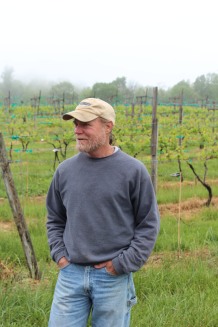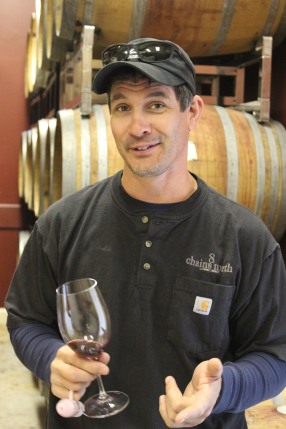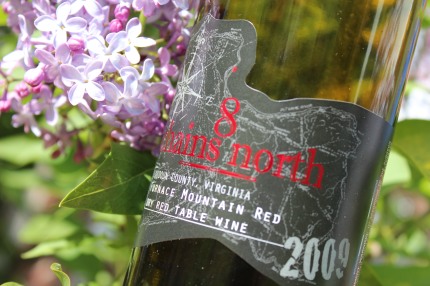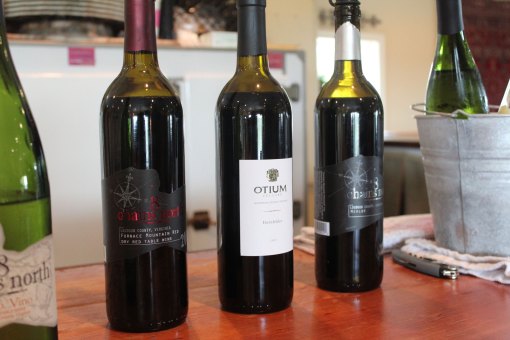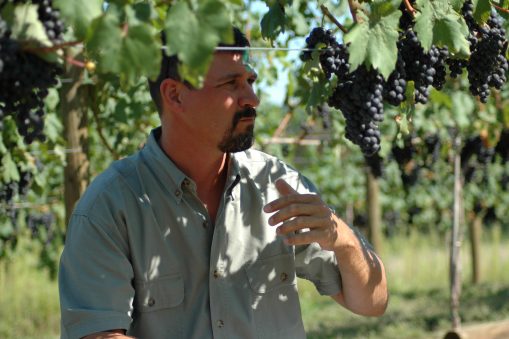Last night we took part in a twitter tasting to help people “Discover DC’s Wine Country” – otherwise known as Loudoun County. We’ve been talking about this for a few weeks, and in my opinion, it was quite a successful event. It was all I could do to try to keep up with the tweeting as I did my part as one of the “hosts” to try to keep tasters from around the country moving through the wines in the same order and on schedule. The tweets were flying. These included both positive and negative impressions of wines – after all, palates differ – and lots of questions to the winery representatives who joined the discussion.

The wines we tasted were the 2009 Nevaeh White from Tarara Winery ($30 – not yet released), the 2009 Ottantotto Viognier from Notaviva Vineyards ($20), the 2008 Furnace Mountain Red from 8 Chains North ($22), the 2007 Cabernet Franc Reserve from Breaux Vineyards ($30/$40 – not yet released), and the 2008 Petit Verdot from North Gate Vineyard ($24). Since 2 of these wines are not yet released and 2 are from wineries we’ve yet to visit, we were discovering the wines of Loudoun County right along with the out of state tasters.
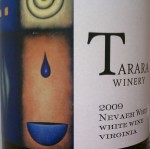 The Nevaeh White was up first. Jordan Harris, the winemaker at Tarara, is moving towards single vineyard blends to better focus on terrior as opposed to a particular varietal. (They’re also using screw caps for all their wines – but that’s a discussion for another day.) The ’09 is 70% viognier and 30% chardonnay, and it was definitely my favorite of the two whites. It had a great viognier nose with a lot of floral and tropical notes. On the palate, I got pineapple, orange, and some stone fruit flavors along with some soft oak notes. There was also some really interesting spice to the finish 9maybe cinnamon?) that i wasn’t expecting to find from these grapes. I definitely prefer stainless viognier to oaked, but the oak here was light enough that I wasn’t really bothered by it (Jordan used 30% new oak). General consensus was that the chard added some weight to the blend, but I definitely found the viognier to be dominant. I also know that we need to get back to Tarara to try more of Jordan’s wines. I just wish they were priced a little lower so that could be wines we’d enjoy more often. Food pairing suggestions were flying for this wine, but the winner seemed to be chicken with apricot chutney from the Swirl Girls.
The Nevaeh White was up first. Jordan Harris, the winemaker at Tarara, is moving towards single vineyard blends to better focus on terrior as opposed to a particular varietal. (They’re also using screw caps for all their wines – but that’s a discussion for another day.) The ’09 is 70% viognier and 30% chardonnay, and it was definitely my favorite of the two whites. It had a great viognier nose with a lot of floral and tropical notes. On the palate, I got pineapple, orange, and some stone fruit flavors along with some soft oak notes. There was also some really interesting spice to the finish 9maybe cinnamon?) that i wasn’t expecting to find from these grapes. I definitely prefer stainless viognier to oaked, but the oak here was light enough that I wasn’t really bothered by it (Jordan used 30% new oak). General consensus was that the chard added some weight to the blend, but I definitely found the viognier to be dominant. I also know that we need to get back to Tarara to try more of Jordan’s wines. I just wish they were priced a little lower so that could be wines we’d enjoy more often. Food pairing suggestions were flying for this wine, but the winner seemed to be chicken with apricot chutney from the Swirl Girls.
 We then moved on the Ottantotto Viognier (with 1% chard). I wasn’t a huge fan of this wine when we visited Notaviva, and I’m still not. It’s fine – don’t get me wrong – but it wasn’t what I look for from viognier. Again, oak made an appearance… On the nose, I got light vanilla, orange blossom, and a tiny hint of tropical fruit. I like a bit more fruit, but at least the oak wasn’t deadening everything. The oak did hit me right up front on the palate with some floral vanilla and a bit of generic tropical fruit behind that. As it warmed up, the pineapple and citrus got more prominent, but it also get a bit harsher on the finish.
We then moved on the Ottantotto Viognier (with 1% chard). I wasn’t a huge fan of this wine when we visited Notaviva, and I’m still not. It’s fine – don’t get me wrong – but it wasn’t what I look for from viognier. Again, oak made an appearance… On the nose, I got light vanilla, orange blossom, and a tiny hint of tropical fruit. I like a bit more fruit, but at least the oak wasn’t deadening everything. The oak did hit me right up front on the palate with some floral vanilla and a bit of generic tropical fruit behind that. As it warmed up, the pineapple and citrus got more prominent, but it also get a bit harsher on the finish.
 The reds began with the Furnace Mountain Red blend. Prior to last night, we’d tried one 8 Chains North wine when we tasted at Fabbioli Cellars, but this was a new wine to us. It’s a blend of Malbec (33%), Cab Sauv (30%), Petit Verdot (30%), Cab Franc (5%), and Merlot (2%). This wine was not for me. The nose was very dark and earthy, but in a way that was not working for me. I was getting some decaying leaf funk. The fruit did come out on the palate, however. I was getting dark fruit, oak, and a bit of herbal once I swirled the heck out of the wine to open it up. Some people seemed to really like it, but I didn’t find it well balanced. It’s a fine wine but nothing special. It might benefit from more time in the bottle, but since it’s closed with a synthetic cork, you can’t trust it to last for more than a few years.
The reds began with the Furnace Mountain Red blend. Prior to last night, we’d tried one 8 Chains North wine when we tasted at Fabbioli Cellars, but this was a new wine to us. It’s a blend of Malbec (33%), Cab Sauv (30%), Petit Verdot (30%), Cab Franc (5%), and Merlot (2%). This wine was not for me. The nose was very dark and earthy, but in a way that was not working for me. I was getting some decaying leaf funk. The fruit did come out on the palate, however. I was getting dark fruit, oak, and a bit of herbal once I swirled the heck out of the wine to open it up. Some people seemed to really like it, but I didn’t find it well balanced. It’s a fine wine but nothing special. It might benefit from more time in the bottle, but since it’s closed with a synthetic cork, you can’t trust it to last for more than a few years.
 The Breaux Cab Franc was one I was particularly interested to try. The label lists the ABV (alcohol by volume) as a whopping 16.4%. I actually got a sneak peak of this from the barrel when I was at Breaux the day before the Drink Local Wine conference. Since then, they’ve decided to bottle it as a reserve for their wine club, and they plan to release it in another year or so. This was one crazy dark wine, and I think almost any one would be hard pressed to peg this as a cab franc. When i first popped the wine open, there was a hint of dark fruit, but it was really tight. Rather than just leaving the bottle open, I decided to decant some of it, and it really made a difference. After a few hours in the decanter, the nose was a ton of rich chocolate along with some dried fruit. On the palate, I got oak, cherry, and prunes. The wine wasn’t as hot as I feared it would be, but it was still hotter than I prefer, and the oak and the heat just became more prominent as I continued to sip. If I can ever get my hands on a second bottle of this wine, I’d love to cellar it and see what it’s like in another 5-10 years. It really needs some time…
The Breaux Cab Franc was one I was particularly interested to try. The label lists the ABV (alcohol by volume) as a whopping 16.4%. I actually got a sneak peak of this from the barrel when I was at Breaux the day before the Drink Local Wine conference. Since then, they’ve decided to bottle it as a reserve for their wine club, and they plan to release it in another year or so. This was one crazy dark wine, and I think almost any one would be hard pressed to peg this as a cab franc. When i first popped the wine open, there was a hint of dark fruit, but it was really tight. Rather than just leaving the bottle open, I decided to decant some of it, and it really made a difference. After a few hours in the decanter, the nose was a ton of rich chocolate along with some dried fruit. On the palate, I got oak, cherry, and prunes. The wine wasn’t as hot as I feared it would be, but it was still hotter than I prefer, and the oak and the heat just became more prominent as I continued to sip. If I can ever get my hands on a second bottle of this wine, I’d love to cellar it and see what it’s like in another 5-10 years. It really needs some time…
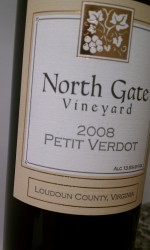 The last wine of the evening was the North Gate Petit Verdot (with 10% cab sauv). They’re not yet open to the public, so we’ve never had the opportunity to try their wines. I’m now excited to plan a visit when their new tasting room opens in 2012. This was my favorite of the evening. When I first opened it, I noted some dark fruit and earth, but it was also really tight, so out come a second decanter. I got some earthy notes (maybe tobacco?), raspberry and violet wit this wine. The fruit was quite bright and there was some really nice acid that just made me long for a great meal to go with this wine. My only complaint was that the finish was too short. That wouldn’t stop me from buying another bottle if I could find one, however.
The last wine of the evening was the North Gate Petit Verdot (with 10% cab sauv). They’re not yet open to the public, so we’ve never had the opportunity to try their wines. I’m now excited to plan a visit when their new tasting room opens in 2012. This was my favorite of the evening. When I first opened it, I noted some dark fruit and earth, but it was also really tight, so out come a second decanter. I got some earthy notes (maybe tobacco?), raspberry and violet wit this wine. The fruit was quite bright and there was some really nice acid that just made me long for a great meal to go with this wine. My only complaint was that the finish was too short. That wouldn’t stop me from buying another bottle if I could find one, however.

From my perspective, a fun time was had by all. The only real downside for me was that the tastelive site was really clunky to use. That meant we had 3 computers going. I had the tastelive site up on the desktop, and I mostly tweeted from that platform. I also had my laptop open next to the monitor so that I could follow the tweet stream using tweetdeck. Grape Envy Guy was also using our netbook to follow along.

I need to end by giving a shout out to my fellow hosts, Frank from Drink What You Like & Paul and Warren from Virginia Wine Time. I had a great time working with you guys on the behind the scenes stuff. Thanks for being such amazing collabroators.
So, were any of you twitter lurking last night? Does this make you want to Discover the wines of Loudoun County? Do you have any brilliant ideas for future twitter tasting? (The Virgina Wine Board may try to organize some more…)
(FYI, all these wines were received as samples from the wineries.)








